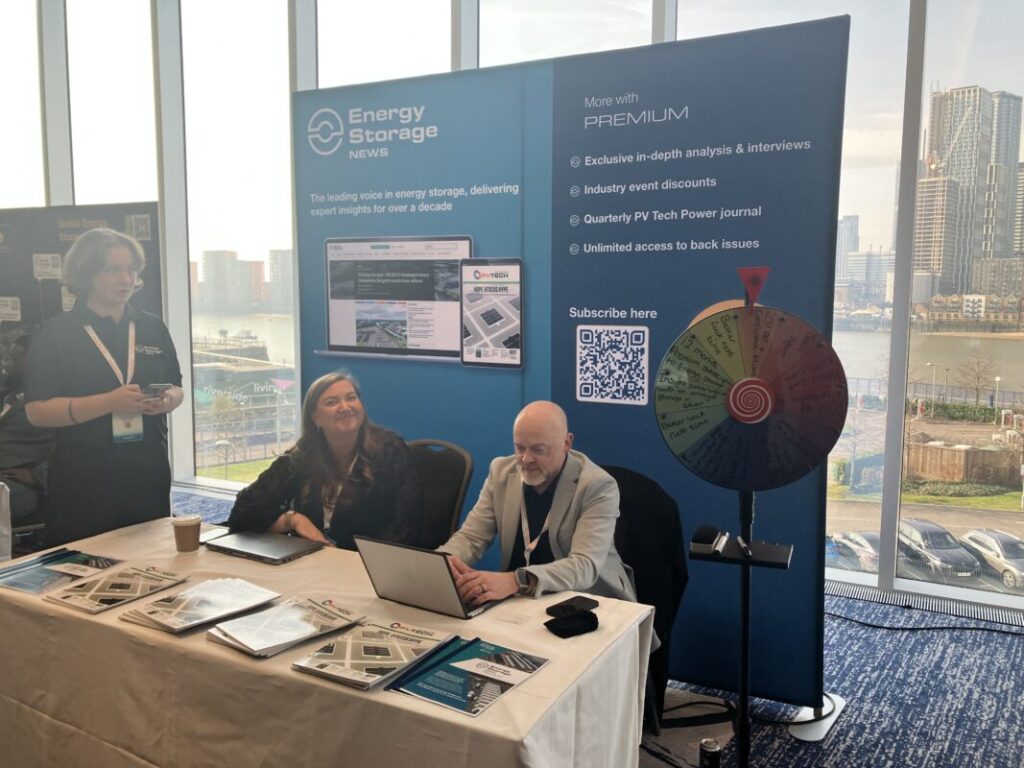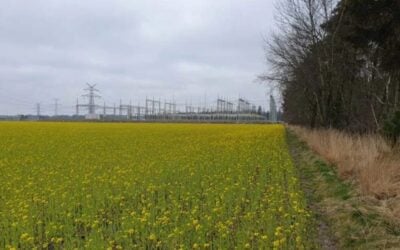
The Energy-Storage.news team brings you daily highlights and insights from the Energy Storage Summit EU in London, UK.
Now in its tenth year, the Summit has been both an opportunity to learn about the European market, and to help contribute to its development. The event has grown and grown, just as the industry around it has, and it’s our privilege to give you a taste of what we’ve experienced today. Stay tuned for tomorrow’s instalment.
Enjoy 12 months of exclusive analysis
- Regular insight and analysis of the industry’s biggest developments
- In-depth interviews with the industry’s leading figures
- Annual digital subscription to the PV Tech Power journal
- Discounts on Solar Media’s portfolio of events, in-person and virtual
IEA: ‘Energy storage is a big part of where we want to go’
This morning’s keynote addresses came from former BBC environment correspondent Roger Harrabin, Day One chair, and Brent Wanner, senior energy analyst for the International Energy Agency (IEA).
Harrabin said that society has for many years taken risks on environmental issues, and that while the industry is growing very fast, so too is the issue of climate change. He noted that scientists often talk in very plain language when in public, but in private, many have told Harrabin that they are “very, very scared,” of the climate crisis.
Meanwhile, he said, energy storage is often only an afterthought in the plans of governments, behind the more-hyped but much more distant promise of technologies like hydrogen and carbon capture and storage (CCS).
Wanner meanwhile, also discussed the “sobering realities of where we are.”
“We haven’t even reached peak emissions in the power sector,” he said.
Nonetheless, “energy storage is a big part of where we want to go,” Wanner said as he drew attention to IEA’s reports that have identified the competitiveness of energy storage paired with solar PV in levelised cost of electricity (LCOE) terms. Yet the value of storage is often not yet fully recognised in market design and the policy space.
Even with those headwinds facing the industry, Wanner noted that the pipeline of battery storage projects in development in major power markets is bigger than all fossil fuels combined.
LFP dominance, in-house optimisation and ownership models
Energy-Storage.news editor Andy Colthorpe was honoured to moderate a panel discussion with a twist: our first-ever ask-me-anything session with industry experts.
Responding to audience questions sent in real-time as well as in advance, topics covered included the future ownership modules for BESS assets, methods to ensure optimised performance and revenue streams and the most exciting energy storage technologies of the future.
One audience member asked if it will become the norm for asset owners to trade their own batteries, or will there be an increase in trader and optimiser services?
“It depends on scale,” said Luke Gibson, COO of Field, the UK-headquartered BESS developer. “At a certain level, it makes sense to optimise your own assets.”
However, he said that the ability to optimise and trade batteries in-house requires a high level of performance and technical knowledge both to receive financial backing and to consistently handle the assets at a high standard.
‘In general the European approach is to let the market decide’
Another panel this morning discussed the best approaches to procuring energy storage long-term across the different markets that the panellists, a mix of experts, investors and asset owner-operators, are involved in.
In some countries, like the UK, Germany, Sweden and the Netherlands, grid-scale energy storage markets have emerged largely through merchant opportunities without any long-term state-led procurements or revenue incentives, like a capacity market (CM). Whereas elsewhere, like Spain, Italy, Portugal and much of Central and Eastern Europe (CEE), the markets have been kicked off by procurement and financial support schemes.
One audience member asked about the extent to which European markets were designing procurement and support schemes specifically for long-duration energy storage (LDES).
Corentin Baschet, head of market analysis for Clean Horizon, pointed out that only one European country so far has done this in a targeted way, but other procurements could support LDES too depending on your definition.
“MACSE in Italy goes up to eight hours, but in general the European approach is to let the market decide. The UK is the only one with a scheme specifically targeting LDES rather than lithium-ion. But with the price falls, lithium-ion is hard to beat,” Baschet said.
‘Massive opportunities in the UK and EU’
The “massive opportunities” in the UK and European Union (EU) for battery storage are driven by a combination of “natural fundamentals and policy directives,” Michael Bennett of US-headquartered system integrator Powin told us.
There is already a lot of storage deployed and a lot of experience in operating it from the market’s formative years where the focus has largely been on ancillary services, Bennett said in a brief interview on Day Zero, before doors officially opened.
“The market is pretty mature and ripe for a lot of expansion. It’s a really exciting place. Obviously, tariffs and international policy can sort of swing the pendulum around to what market is hot in any given year, but it seems like Europe will be a great place to build storage for years.”
Bennett is Powin’s chief transformation officer (CTrO), and has been with the company since 2020, when it had, until that point, deployed around 300MWh in the field. Today, Powin has more than 17GWh of BESS in operation worldwide.
While that growth has been rapid, Bennett said that signs of the industry’s maturity can be seen in the way that, in the early days of the battery storage buildout, “people just assumed the battery was like your cell phone: you charge it, then discharge it.”
“It’s been really great to see the education of the industry and the owners and operators of the assets have come along and realised how valuable it is to have experienced people to support the execution and delivery and operations of your project. They’re not just single devices that you plug into networks. They’re complex machines and industrial devices and they need a lot of focus.”
‘The expert gap’
On Day Zero, held on Monday 17 February ahead of the show opening, we also spoke with Claudius Jehle, CEO of Volytica. The battery diagnostic analytics provider licenses its technology platform to customers in the heavy-duty mobility and stationary BESS sectors.
Jehle said that Germany-headquartered Volytica is global in outlook, and its biggest customer base is in the US. However, in the past year and a half, it has seen a major uptick in interest in its home country.
The CEO shared Bennett’s outlook on the European market’s ongoing growth potential, but highlighted a bottleneck he said Volytica has encountered.
Many of Volytica’s potential clients, including independent power producers (IPPs) and engineering, procurement and construction (EPC) firms, have in-house battery experts, which Jehle said is essential for any company working with such complex components.
Yet the CEO mentions a study published around a year ago, which found that the disparity between demand for battery experts and experts available for hire in Europe is immense, and it could take roughly 20 years to close that gap.
“Currently, in Germany, it’s estimated that 50,000 people are ‘missing’ from the job market. So, there is a huge lack of expertise,” Jehle said.
He said the gap will be felt acutely as larger portfolios of large-scale BESS are likely to run into the dozens of gigawatt-hours in years to come.
Volytica’s technical solution to help mitigate that pain point is The Sentry, a virtual battery assistant that can be integrated into the processes of EPCs, IPPs, insurance companies and other stakeholders.
Watching over the fleet 24/7, the AI-driven bot assistant will still require human intervention once it identifies something like an operating temperature anomaly but could go some way towards lessening the expert workload, Volytica hopes.
Australia in focus on Day Zero
On Day Zero, invited guests attended a speed mentoring session in association with ReWiRE, energy transition non-profit Regen’s vibrant network for women in clean energy, and The Australia Café, a deep-dive session promoting investor-developer engagement, focused on one of the world’s fastest-growing markets for storage and renewables.
With the Energy Storage Summit Australia returning to Sydney in March for its second year, this writer opted for a primer from speakers including representatives of Austrade, the Australian investment and trade development agency, the government Department for Climate Change, Energy and Water (DCCEW), the states of Queensland, New South Wales, Victoria, South Australia and Tasmania, alongside developers and investors.
Hosted under Chatham House Rules—meaning direct quotes from speakers cannot be reported—the discussion covered everything from Australia’s 82% by 2030 renewable energy target, the phaseout of coal by 2038 and the energy storage deployments that will enable them, to the current market opportunities and challenges ahead.
The big takeaways included:
- The renewable energy transition is well underway, and while there may be bumps in the road, coal is definitely not coming back.
- The Australian grid network is stretched across vast distances; it’s often described as a “long, skinny grid,” and energy storage is the perfect mitigator for congestion and curtailment.
- The federal government is committed to enabling the transition, but energy policy is ultimately set on a state-by-state basis at a regional level.
- Multiple states are positioned to attract battery and other clean energy manufacturing, offer cheap, abundant renewable energy for heavy industry and deposits of critical materials vital to the battery supply chain.
- The focus is already turning to LDES in state and territory energy system planning.

Expo expansion
This year, while the conference takes centre stage, the expo hall has been expanded to accommodate more than 80 exhibitors.
At the Energy-Storage.news stand, visitors have the chance to spin the Wheel of Fortune and win prizes, including a year’s subscription to ESN Premium, as well as pick up print editions of PV Tech Power Vol. 41.
We’d like to thank all of the sponsors, exhibitors, speakers and, above all, the delegates who made the show possible.
The Energy Storage Summit EU 2025 is taking place today and tomorrow (19 February) at the Intercontinental Hotel at the O2, London.






